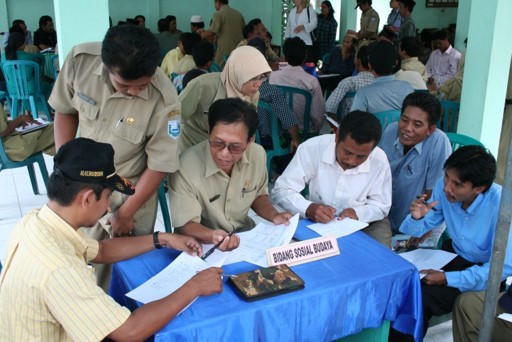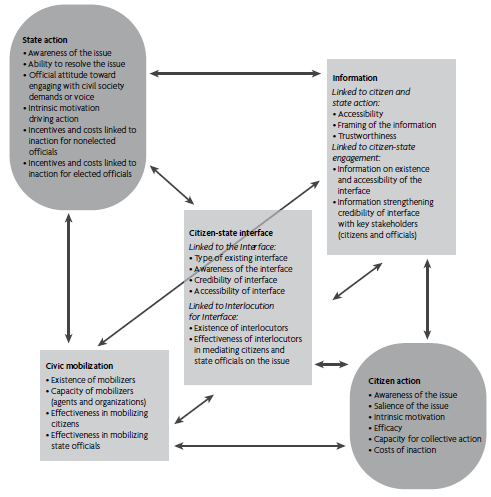Programs to strengthen social accountability – citizens’ efforts to constrain the state’s use of power through various collective action tools and processes – must always consider context. It is critical that practitioners identify and account for unique on-the-ground variables that will influence interventions and their outcomes. Ignoring context leads to simply replicating and imposing “widgets” that have been effective in other settings, resulting in the indelicate and problematic imposition of uniform institutional blueprints.
But practitioners can move too far in the other direction, as well. Lately, exhortations to consider contextual factors that influence interventions to strengthen social accountability have grown louder, and their prescriptions increasingly complex.
Most recently, a World Bank publication entitled Opening the Black Box: Contextual Drivers of Social Accountability provides a “framework and … a set of drivers [that ] can be used iteratively to analyze contextual opportunities and constraints and to identify change paths that will allow accountability demands to advance … from the country level, to the sector level, and down to a specific frontline service delivery unit” (Grandvoinnet et al. 2015 [pdf]: 18-19). The publication is an impressive and thoughtful compilation of very thorough background research (such as Bukenya, Hickey, and King 2012 [pdf] and O’Meally 2013). However, the authors’ proposed framework (see Figure 1 below) is quite elaborate, with each of five elements – state action, civic mobilization, citizen-state interface, information, and citizen action – further broken down into four to six components, each of which has structural, actor-centered, or short- and long-term contributing factors. As a result, the information required for contextual analysis is extensive (see p. 131-145).
Figure 1: Analytical framework presented in Grandvoinnet et al. (2015)
Source: Grandvoinnet, Helene, Ghazia Aslam, and Shomikho Raha. 2015. ‘Opening the Black Box: The Contextual Drivers of Social Accountability‘. New Frontiers of Social Policy series. Washington, DC: World Bank. doi:10.1596/978-1-4648-0481-6. License: Creative Commons Attribution CC BY 3.0 IGO (p. 12).
To be sure, such analysis has clear value to researchers. But for on-the-ground practitioners and implementers, the requirements are at times overwhelming and impractical.
First, contextual data are often costly to gather. Significant investments of time and resources are required to collect complete information on contextual indicators. In addition, information about some contextual variables, such as citizens’ and officials’ intrinsic motivations, is unlikely to be readily available, leaving holes in the framework and undermining its utility for an a priori understanding of the interventions’ viability.
Second, it is rarely possible to preemptively identify the factors that are most relevant to effective citizen voice and government response. Among the more striking findings in our recent research on social accountability in Indonesia (Wetterberg et al. 2015), presented at the 2015 Australasian Aid Conference, is that citizens successfully implemented program-supported social accountability tools in locations with both more and less conducive contextual characteristics (in terms of existing complaints mechanisms, prior provider-user relations, and past social accountability efforts). The same held true for health facilities’ responsiveness to service users. As intervention districts were chosen at random, contextual factors varied widely, as did their anticipated impact on social accountability. However, the data from our study indicated there was no clear pattern of contextual factors among sites with similar outcomes, at both facility and district levels.
We interpret this finding as attesting to the importance of micro-level drivers of social accountability (Joshi 2014). For instance, a recurring contextual factor in our past and ongoing research is the role of personal agency: individual state actors’ willingness to engage with citizens’ efforts proved to be important in launching, sustaining, and thwarting social accountability. Importantly, these actors were often at different levels (facility managers, technical officials, and elected leaders) and supportive or counter-productive at different points in the intervention cycle (during implementation, after positive effects were evident, or during replication). Such micro-contextual effects and variables cannot be systematically anticipated and incorporated into project designs.
These tendencies underscore the fact that social accountability interventions are often both complicated – multi-site and multi-level – and complex, meaning that causality may be recursive, effects disproportionate at critical times, and outcomes emergent (Rogers 2008). These characteristics suggest that, rather than undertaking massive data collection to document baseline contextual variables and track them over time, program initiators and practitioners should limit their attention to a small set of contextual variables directly associated with barriers to social accountability and service delivery improvements to identify interventions that may prove effective. Possibilities for information that may be gathered relatively easily include local resource distributions, degree of effective decentralization, level of civil society development, and past service performance. Additional factors may be added over time, as they emerge during implementation.
A gradual, iterative approach that adjusts interventions as effects of prior efforts become evident – such as Problem-Driven Iterative Adaptation – can, in fact, make social accountability strengthening more locally relevant. Further, ensuring that project implementation is carried out by practitioners with thorough understandings of the local contexts can facilitate program adjustments, identification of emergent factors, and opportunities for strengthening social accountability as they emerge.
Following such an approach will help social accountability practitioners design and implement interventions that reflect consequential contextual elements, without subjecting themselves and their programs to the tyranny of context.
Anna Wetterberg is a Social Science Research Analyst at RTI International. This blog post is based on a paper presented [pdf] at the 2015 Australasian Aid Conference.







I agree with these comments. However well-designed and well-tested social accountability interventions are not merely iterative but already address multiple contextual factors – they don’t start from scratch. The iterations by being already embedded in large numbers of cycles of practice and learning emerge in different settings more readily (and, as Patrick Kilby will tell you social accountability is very old). Some macro factors are less amenable to this, but localised ones (like inequalities creating inequitable power relations) are addressed in designs. The evidence about interventions ‘going with the grain’ of culture – recognising that culture contains important enablers of public action and is not just a hindrance – can also be relevant. I suspect we underestimate the extent to which local people under conducive conditions can do their own ‘social and political analysis’ which despite being less sophisticated than PEA is better informed about and more finely attuned to local politics. Naturally that may deter action, but it can facilitate locally-informed iterative action by actors working collaboratively at their own pace – this can reduce risks and address fears associated with public action.This combination of considerations makes long lists of contextual factors (others being those we found evidence for in our 2014 3ie realist review for DFID) less scary for those wanting to put research into practice. For those who aren’t aware of our review, Prof Patricia Rogers led the research and here is the link.
Bill
Yes, I would largely agree—especially Brendan’s point A. Put another way: The problem isn’t so much the tyranny of context, but rather the hubris of analysis. There are limits to what can be learned through the research that precedes program design. The most important nuances of contexts only reveal themselves over the course of iterative action.
Many thanks for this Anna (and Derick and Jana).
I think it’s the best explanation there is of why it’s important, and how it is possible, to find a middle ground between “context is king” and “one-size fits all”.
It’s very much in line with our new strategy and its focus on country-level learning, but explains things more clearly still.
https://www.globalintegrity.org/wp-content/uploads/2015/07/GlobalIntegrityLearningtoopengovernanceStrategysummary.pdf
best wishes,
Alan
Like Alan, I appreciate the attempt to find a reasonable middle ground. While I find the ‘Opening the Black Box’ report very helpful and useful, it does carry some danger of A) being (mis)interpreted to mean that if you ‘get the analysis right’ that will tell you what tool/methodology/linear intervention to adopt, and B) be so intensive as to imply that only big INGOs or contractors can successfully implement social accountability projects. Rather I the underlying message, as you and Alan note, is the importance of balancing analysis and adaptation.
Two small additions from my own thinking on these can be found here, on analysis
and politically-informed social accountability.
But at the end, I think there still needs to be more emphasis on building collective capacity among citizens.
Sorry for the excess of linkages, but this touches on a lot of ongoing conversations as well.